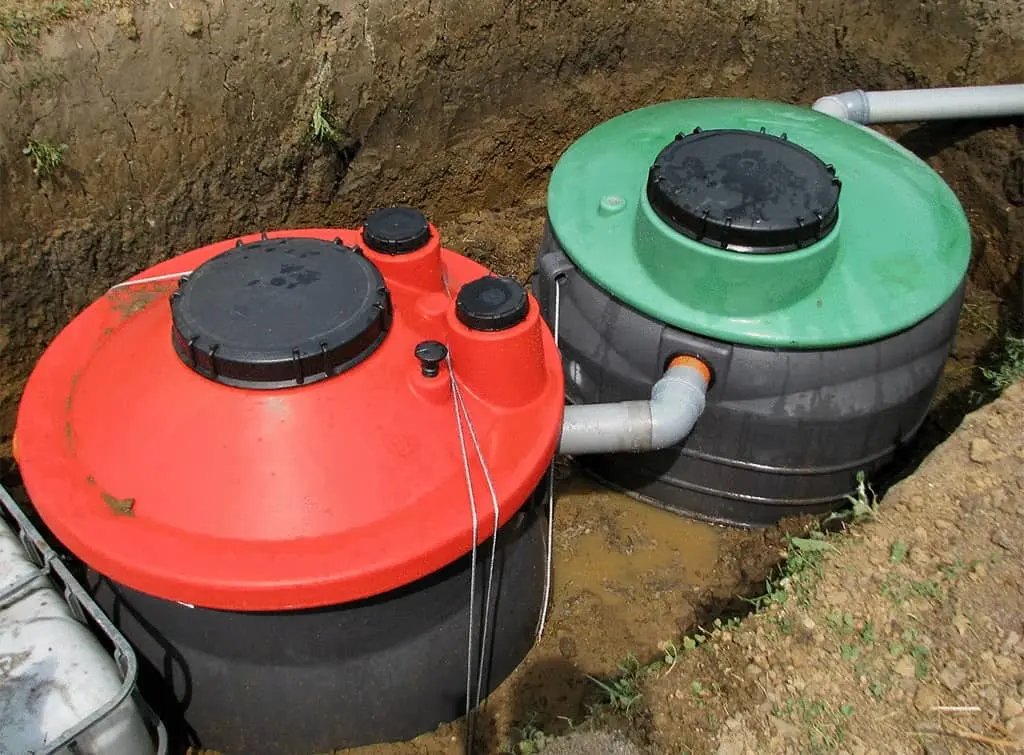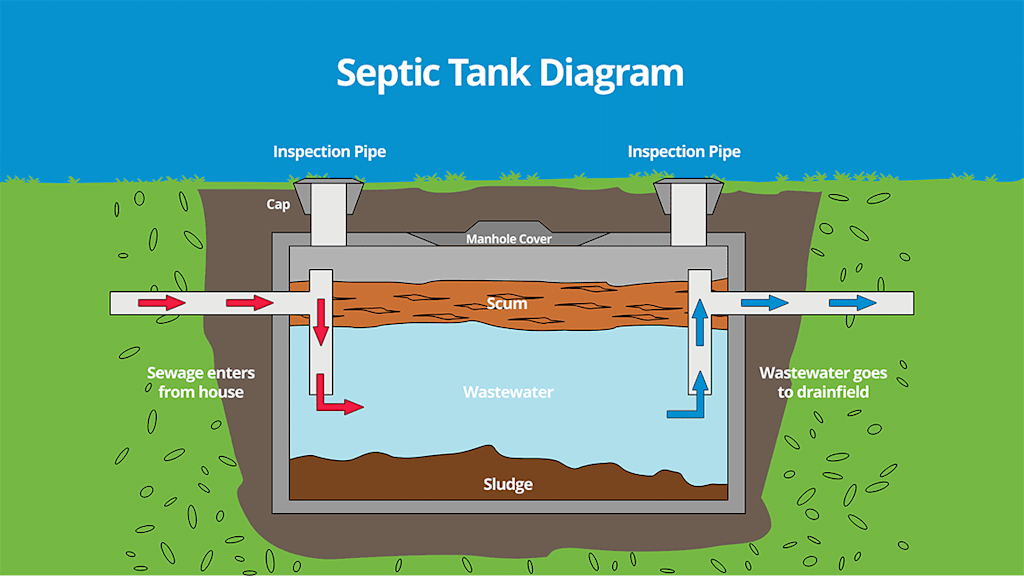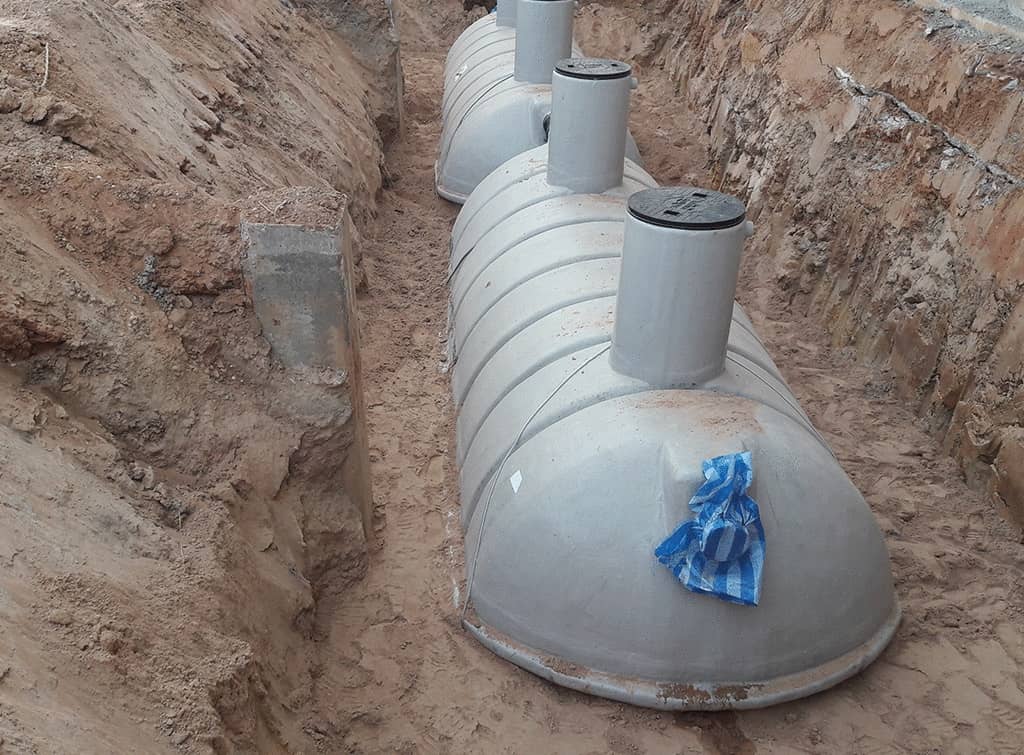Blog>Expert Advice>What is a septic tank?
Last updated: 13 September 2024
What is a septic tank?
Wondering what a septic tank is and how exactly it works? Read on to find out how this drainage system works.

What is a septic tank used for?
A septic tank is a type of onsite wastewater treatment system (OSWTS). These systems are used to breakdown, store and drain waste from a property's toilets, baths, showers and sinks.
The majority of homes in the UK are linked up to a local sewer network. Septic tanks are often installed instead when connecting to a sewer line is too challenging or expensive.
Septic tanks are installed into the ground and are typically made from concrete, bricks or glass reinforced plastic. The majority of septic tank systems include a drainage field to treat the drained wastewater.
Types of septic tank
Septic tanks are available in different shapes and sizes. Also, not all septic tanks store and treat waste in the same way.
The three types of septic tank most commonly used here in the UK include:
Traditional septic tank
Typically found on older properties, traditional septic tanks are often made from brick or concrete. These tanks laterally filter waste to a drainage field through two of three connected chambers.
Onion shape septic tank
As the name suggests, these more modern tanks are shaped like an onion. Made from glass reinforced plastic with a large top, these tanks require a significant amount of excavation and installation work.
Unlike traditional tanks, waste flows upwards in an onion shape septic tank instead of laterally through separate chambers.
Shallow dig septic tanks
These tanks are a modern version of the old concrete septic tanks. The small tanks can be installed into a shallow hole and waste flows laterally through the system.
Unlike onion septic tanks, shallow dig models do not need to be sealed in place with concrete. Small and lightweight, shallow dig septic tanks are often easier to install.
See the tradespeople we've checked and recommend for your job
How do septic tanks work?
Every time you flush something down the drain, the waste will end up in your septic tank. Septic systems can vary but they essentially all have the same purpose - dealing with your property's wastewater.

Let's take a closer look how septic tanks work:
Waste enters the tank
Wastewater enters a septic tank through the inlet pipe. This waste comes from your home's toilets, baths, showers and sinks. Wastewater from your dishwasher and washing machine will also be drained into the septic tank.
Waste separates
The wastewater will separate once inside of the tank. Heavy solid waste will sink to the bottom of the tank, forming a layer of sludge. Fats, oil and greases (FOG) will rise to the top, creating a layer of scum.
Fluid wastewater is found between the layers of sludge and scum.
Treatment phase
Septic tanks partially treat wastewater as well as storing it. Naturally occurring bacteria separates the liquid waste and filters the solid waste to the bottom of the tank.
The fluid waste - also known as effluent - can be drained from the tank. Waste that settles at the bottom of the tank will need to be periodically emptied by a professional.
Drainage
The treated wastewater exits the septic tank through the outlet pipe. This liquid is then discharged into the drainage field. Here the effluent moves through perforated pipes and is further treated and broken down as it percolates down into the soil.
Current regulations require all septic tanks to discharge waste into a drainage field or sewage treatment plant. Waste can no longer be discharged into a watercourse, such as a river or stream.
What to know about septic tanks before installation
Now you know what a septic tank is and how one works, let's start planning your installation.
There is more to installing a septic tank than just digging a hole in the ground. Before installing the tank itself, you will likely also need to apply from planning permission and building regulations.
It is also essential for your septic tank to comply with current General Binding Rules. These regulations cover everything from the location of the tank to installing a compliant drainage field.
Read our complete guide to installing a septic tank to learn everything you need to know about the current General Binding regulations.
Here is a checklist of everything you need to do before installing a septic tank:
Check that your septic tank system complies with the current General Binding Rules
Apply for planning permission if you are installing a new septic system. You can do this by contacting your local council and speaking to the Local Planning Authority (LPA)
Apply for a septic tank permit if your system does not comply with current General Binding Rules
Check that your septic system meets all required building regulations
Hire a professional septic tank installation service to plan and install your septic system
Septic tank costs
Septic tank installation costs vary and are determined by the tank size and model.
The average cost of a small septic tank is £4,200. This increases to £5,000 for a medium size tank and £6,000 for a large tank. These prices include the cost of the tank, plus the price of labour for the excavation and installation work.
Replacing an old septic tank with a newer model costs £4,000 on average.
Septic tank cost guide: Installation, replacement and repair costs
The cost to install a septic tank may be less than you think. It could even save you money in the long term. Take a look at everything you need to know in our septic tank cost guide.
FAQs
What to do when septic tank is full?
Signs of a full septic tank include bad smells around the installation and slow draining. Your tank may also be full if you notice a back up of waste in your home's toilets, showers, baths and sinks.
A full septic tank will need to be pumped or completely emptied by a professional.
The majority of septic tanks need to be emptied approximately every three years. Smaller tanks will need to be emptied annually.
Septic tank pumping involves removing the solid waste and sludge only. Pumping is a different service to professional emptying but is vital to maintaining your septic tank.
What is the cost of emptying a septic tank?
The cost of emptying a septic tank is determined by the size of the tank.
It costs an average of£175 to have a small tank emptied. This service fee can increase up to£312.50 for an extra large tank.
Take a look at our septic tank emptying cost guide for more information.
What is a leach field?
Also known as a septic drain field, leach fields are installed close to a septic tank and allow treated liquids to seep into the surrounding soil.
These fields are built using perforated pipes and are used in the majority of traditional septic tank systems. Read our complete guide to installing a septic tank to learn more about how leach fields work.
Key takeaways
Septic tanks are a type of onsite wastewater treatment system (OSWTS)
A septic system works by separating waste into three layers inside of the tank
Liquid wastewater is partially treated in the tank and drained into a septic drainage field
Septic tanks need to be periodically emptied and well maintained to stay in full working order
It costs between £4,200and £6,000to have a septic tank professionally installed
Finding a septic tank installer near you
Enter your postcode below to get started.
See the tradespeople we've checked and recommend for your job
See the tradespeople we've checked and recommend for your job



